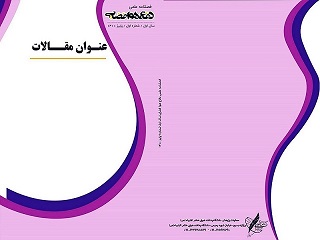نوع مقاله : مقاله پژوهشی
نویسندگان
1 استادیار عضو هیئت علمی دانشگاه پدافند هوایی خاتم الانبیاء(ص)
2 کارشناسی ارشد، گروه آموزشی مکانیک، دانشگاه پدافند هوایی خاتمالانبیاء(ص)، تهران، ایران
3 کارشناس، گروه آموزشی مکانیک، دانشگاه پدافند هوایی خاتمالانبیاء(ص)، تهران، ایران
چکیده
در این پژوهش تأثیر عواملی مانند سرعت و دمای جریان خنککننده، شار حرارتی و زاویه قرارگیری پره بر میزان انتقال حرارت بررسی شده است. برای این منظور از پرهی سهموی مقعر با زوایای ۰، ۴۵ و ۹۰ درجه نسبت به جریان خنک کننده (هوا)، سرعت جریان (بین 1 تا 5/2 متر بر ثانیه) و شار حرارتی 5/18 و 6/4 کیلووات بر متر مربع استفاده شده است. به دلیل رسانایی حرارتی بالا، جنس پره از فلز آلومینیوم انتخاب گردیده است. نتایج نشان داد که نوک تیز و انحنای پره سهموی علاوه بر کاهش وزن و حجم پره سهموی نسبت به پره مثلثی، موجب بهبود یکنواختی جریان و افزایش سطح تماس حرارتی و در نتیجه کاهش افت فشار و تنشهای حرارتی و افزایش طول عمر پره میگردد. انتهای بسیار تیز پره سهموی باعث کاهش پدیدههای گردابی و تغییرات ضریب انتقال حرارت شده و با افزایش سرعت جریان، میانگین ضریب انتقال حرارت افزایش مییابد. همچنین تغییر زاویه بین جریان سیال و امتداد پره تأثیر چندانی بر کارایی پرهها نداشته و افت فشار تنها به سرعت جریان وابسته است؛ بهطوریکه کمترین افت فشار در زاویه برخورد صفر درجه مشاهده شد. افزایش سرعت جریان بهطور قابلتوجهی منجر به افزایش افت فشار میشود، در حالی که تغییر زاویه پره و شار حرارتی تأثیرات کمتری بر افت فشار دارند. در زاویه برخورد صفر درجه، به دلیل کاهش مقاومت سطح مقطع پره در برابر جریان، کمترین میزان افت فشار مشاهده شد.
کلیدواژهها
موضوعات
عنوان مقاله [English]
Experimental Investigation of Heat Transfer and Efficiency of the Parabolic Fin under Various Heat Flux, Flow Velocity, and Fin Angles
نویسندگان [English]
- Mohammad Pourjafargholi 1
- alireza gholami 2
- Mohammadreza Karimi 3
1 Assistant Professor, Faculty Member, Khatam Al-Anbiya Air Defense University
2 Department of Mechanical Engineering, Air Defense University, Tehran, Iran
3 Department of Mechanical Engineering, Air Defense University, Tehran, Iran
چکیده [English]
In this study, has been investigated the effects of key parameters, including coolant flow velocity and temperature, heat flux, and fin angle, on heat transfer performance. For this purpose, a concave parabolic fin has been used with angles of 0, 45, and 90 degrees relative to the coolant flow (air), flow velocity (between 1 and 2.5 m/s), and heat flux of 18.5 and 4.6 kW/m2. Due to its high thermal conductivity, the fin material has been selected aluminum. Results reveal that the parabolic fin's sharp-tip and curvature not only reduce its weight and volume compared to a triangular fin but also improve flow uniformity and thermal contact area. This leads to reduced pressure drop and thermal stresses, ultimately enhancing fin durability. The parabolic fin’s sharp end further minimizes vortex formation and variations in the heat transfer coefficient, and as flow velocity increases, the average heat transfer coefficient rises. Moreover, the analysis shows that changes in the angle between the fluid flow and fin alignment have minimal impact on fin efficiency, with pressure drop primarily influenced by flow velocity. The lowest pressure drop occurs at a flow angle of zero degrees. Additional, findings indicate that while an increase in flow velocity substantially raises pressure drop, changes in fin angle and heat flux have less pronounced effects. At zero-degree flow alignment, the minimal cross-sectional resistance of the fin results in the lowest observed pressure drop.
کلیدواژهها [English]
- Heat transfer in fins
- parabolic geometry
- flow angle
- experimental study

